

Giovanni Maria Colombi is described as “Orvietano” (from Orvieto) in an inscription in San Paolo there (see below). He was documented as a member of the Accademia di San Luca, Rome in 1638-9, at which time he worked alongside Giovanni Francesco Romanelli in Palazzo Barberini. In 1658, the records of the academy recorded him as “unknown”, probably because he had, by then, returned to Orvieto.
Until recently, Giovanni Maria Colombi’s work in Orvieto was known only from an inscription in the church of San Paolo (see below) that relates to its frescoes. Unfortunately, the date given was misread, and this undermined confidence in the authenticity of the inscription. However, another inscription discovered on an altarpiece (1637) of the Profession of St Clare in the convent of the Buon Gesù has confirmed the attribution of the frescoes in San Paolo. Further investigation of the associated inscription has confirmed that the original reading of 1617 should be corrected to 1647. The last surviving record of Giovanni Maria Colombi in Orvieto was a now-lost watercolour (1658) of the reliquary of the Sacro Corporale.
Orvieto
Scenes from the life of St John the Baptist (ca. 1630)
These frescoes in the lunettes of the walls of the Oratorio della Misericordia are attributed on stylistic grounds to Giovanni Maria Colombi. They depict:
-
✴the annunciation to Zacharius;
-
✴the birth of St John the Baptist;
-
✴the preaching of St John the Baptist; and
-
✴the beheading of St John the Baptist.
Profession of St Clare (1637)
This altarpiece in the private chapel of the nuns of the Chiesa del Buon Gesù came from Santa Chiara. It was taken to Paris in the Napoleonic era, when the nunneries of Orvieto were suppressed, but subsequently returned to city. Since Santa Chiara never re-opened, it was given to the nuns of the Chiesa del Buon Gesù.
The altarpiece depicts St Clare receiving the habit of a nun from St Francis at the Portiuncula. An inscription was recently discovered on it identified the artist as Giovanni Maria Colombi and gave the date as 1637.
Scenes from the life of St Paul (1647)

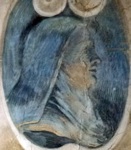
According to an inscription under the left (closed) window of San Paolo, Sister Faustina Monaldeschi commissioned these frescoes on the ceiling and walls of the church from Giovanni Maria Colombi. The earlier reading of the date as “1617” cast doubts about the authenticity of this inscription, but closer examination has revealed the more tenable date (as afar as the likely age of the artist is concerned) of 1647. Sister Faustina is depicted under the arch of the window on the right.
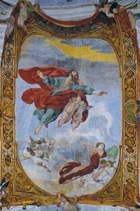
The other scenes are as follows:
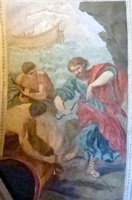
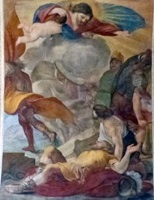
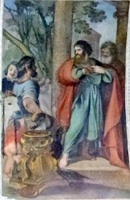
Left wall: Shipwreck of St Paul Conversion of St Paul Sacrifice at Lystra
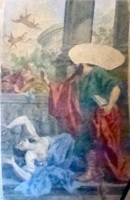
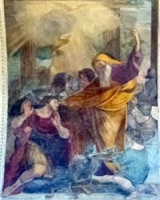
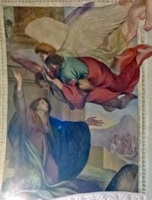
Right wall: St Paul at Ephesus Ananias cures St Paul’s blindness St Paul returns St Plautilla’s veil
Giovanni Maria Colombi included a self-portrait in the fresco of St Paul at Lystra: he is the man on the left, wearing a moustache and a quizzical expression.
Scenes from the lives of Christ and the Virgin (1647)
The will (1647) of Giovanni Battista Cecchetti included a bequest to his sister Giulia, who was a nun at the Monastero del Buon Gesù, that was to be used to commission Salvi Castellucci to decorate the “frontespizio” (almost certainly the apse) of church and the vaults. In fact, this work is attributed on stylistic grounds to Giovanni Maria Colombi.
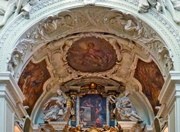
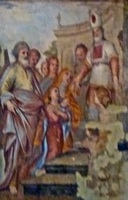

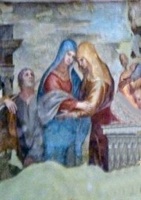
Presentation of the Virgin Presentation of Christ Visitation
The works comprise:
-
✴a panel of the Presentation of Christ, above the high altar; and
-
✴the following frescoes in the apse:
-
•three in the vaults:
-
-the Adoration of the Magi (to the left);
-
-the baby Jesus in glory; and
-
-the Nativity (to the right); and
-
•two on the walls:
-
-Presentation of the Virgin (to the left); and
-
-the Visitation.
Birth of the Virgin (17th century)
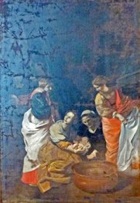
Read more:
G. Sapori and B. Toscano, “Pittura del Seicento e del Settecento: Ricerche in Umbria 4: L' Antica Diocesi di Orvieto”, (2006) Treviso. In particular, see the article here:
L. Carsillo, “Lanfranco, Castellucci, Colombi: il Seicencto a Orvieto” pp 31-4
Return to the page on Art in: Orvieto.

